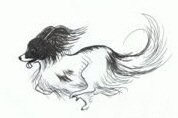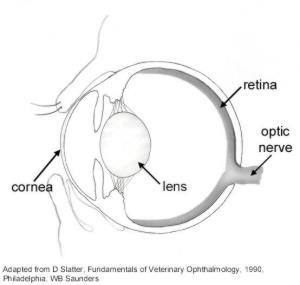

What is progressive retinal atrophy? The cells of the retina receive light stimuli from the external environment and transmit the information to the brain where it is interpreted to become vision. In progressive retinal atrophy (PRA), deterioration of the retinal cells causes blindness. The retina lines the back of the eye. The inner layer is the neural retina (called simply the retina) which has 9 layers, the outermost of which consists of the photoreceptor cells - the rods and cones. The outer layer of the retina is the retinal pigmented epithelium (RPE). In dogs the retina is not mature until 6 or 7 weeks of age. |  | |
| The term progressive retinal atrophy covers several types of inherited degeneration (deterioration) of the retina. Sub-classifications of PRA are based on the age at which dogs show signs of the disease and the type of retinal cell which is affected. | ||
| ||
| What does progressive retinal atrophy mean to your dog & you?
Generalized PRA - early onset: The first sign is generally failing night vision, as early as 6 weeks of age, and this progresses to complete loss of vision by about 1 - 2 years of age. Collies may retain some vision until the age of 2 - 3 years. In miniature schnauzers, poor night vision usually develops later (6 months to a year) and there is advanced loss of vision by 3 to 4 years. Affected Alaskan malamutes are day-blind (hemeralopia) at 8 to 10 weeks of age; night vision is never affected. Generalized PRA (progressive rod-cone degeneration) - late onset: Generally night blindness is noticed between 2 and 5 years of age (depending on the breed) progressing to total blindness within a year or so. Peripheral vision is lost first. Central PRA (CPRA) - retinal pigment epithelial dystrophy (RPED): Loss of vision occurs much more slowly than in generalized PRA, without initial night blindness. Affected dogs may not lose vision completely. Because the changes are in the centre of the retina, affected dogs initially have trouble locating still objects in bright light.
How is progressive retinal atrophy diagnosed? Genetic testing is quickly becoming available for different forms of PRA in different breeds. The advantage of such testing is that it can identify dogs whose sight is unaffected, but who are carriers of the disorder (heterozygotes).
How is progressive retinal atrophy treated?
Breeding advice | ||